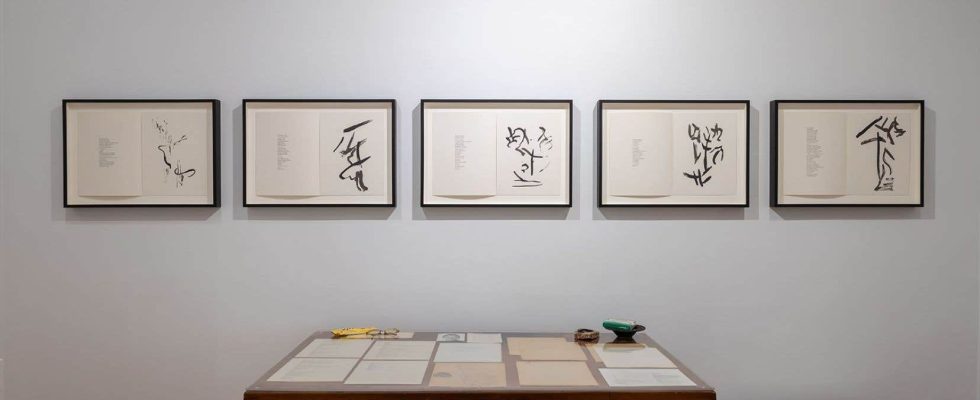A small wind of renewal is blowing through the Guido Molinari Foundation. The arrival in 2023 of Marie-Ève Beaupré as director is reflected in a reorganization of its broadcasting activities. Nothing major, the place remains the same, with its two floors dedicated to exhibitions. But…
For a decade, since the place has been open to the public (2013), it has been possible to see the museumized workshop of Guido Molinari, as he left it when he died a few years earlier. Echoing this creative space accessible on the ground floor, a second workshop has just been set up upstairs, that of “thought”, with manuscripts and books as the main elements.
This section does not only concern the owner of the premises; she also makes room, in an equitable and almost symmetrical manner, for her lifelong companion. Permanent or more precisely “evolving” exhibition – the content will change once a year -, The poetry workshop of Fernande Saint-Martin and Guido Molinari is the first major contribution of the new director.
The former curator of the collections at the Montreal Museum of Contemporary Art wasted no time. Through this somewhat fetishistic scenography (we are treated to the couple’s bookcases and work tables and even Fernande Saint-Martin’s glasses), Marie-Ève Beaupré and her team not only highlight the rich collection under their responsibility, composed works, reference works and “fifteen linear meters of archives”. They ensure that the memory of the former journalist, poet and academic who died in 2019 is not limited to “the wife of…”.
Written expression, as present in both, is shown as an exercise of equal level to gestural expression, examples of which in drawing have been placed here and there. You can also browse original editions of Marouflaged the tongueSaint-Martin, and No wordby Molinari.
This historic room does not put an end to the dynamism that has made the reputation of the Hochelaga establishment. Quite the contrary, since the Molinari Foundation, according to what Marie-Ève Beaupré affirms in an email exchange, will continue to “be involved in current aesthetic and theoretical debates” and to disseminate living artists in “resonance with the issues that Molinari’s work arouses”.
The connections between yesterday and today will be through the presentation of a second, temporary exhibition on the ground floor. The one inaugurated at the same time as The poetry workshop…is the result of the residency enjoyed by Fiona Annis. The photographer shares with Fernande Saint-Martin and Guido Molinari an interest in words, whether they come from poems, intellectual reflections or epistolary exchanges. Who knows if, in the future, these references to writing will not become a trap.
Letters and labels
Correspondence, the title that oversees the works of Fiona Annis, is intrinsic to the Molinari Foundation. Unless I’m mistaken, all the exhibitions since the inaugural Molinari in two stages (2013) were built on the idea of dialogue. From one time to the next, artists, worlds or eras have been brought together, compared, creating marriages that are sometimes expected, sometimes unusual. The two floors favored this play of correspondences, often placing painting and large formats at the bottom, works on paper and more intimate projects at the top.
Most inkjet printing Correspondence take their source from Molinari’s epistolary archives, letters and envelopes received from today historic figures like Paul-Émile Borduas or Barnett Newman. Member of the collective La Société des archives affectives, the Montreal photographer also responds to the aesthetic discussion which takes place one floor higher.
The two series from the residence, as well as a third earlier set included in Correspondence, breathe the theses defended by Saint-Martin and Molinari for the unsaid and for a more in-depth reading than what the surface of things, and of words, allows. Fiona Annis does not document anything, she is more inspired by affect as advocated by the illustrious intellectual in her approach to semiology.
As Marie-Ève Beaupré recalls in the exhibition booklet, “Fernande Saint-Martin has repeatedly affirmed that words, like the objects that surround us in the world, have no fixed meaning or identity. […] since they depend as much on the affective value as on objective properties.
Abstract in nature, Annis’ hybrid photography (analog and digital) follows processes that draw both on the rigor of proven protocols and on his personal intuitions. Made with a macroscopic lens to take, when taking images, the smallest detail, the series Correspondences I-XI (Borduas, Newman, Corbeil, Gauvreau, Murray, Letendre, Saint-Martin, Repentigny, Lalonde, Cameron, Riopelle) does not reproduce words, but the essence of a thought, its emotionality. For the series Letters I-IX, the artist did not use a camera. She worked in the darkroom using the historic wet collodion process and effects created from postage labels used as mattes.
The Molinari Foundation does not change. The former safe of this bank transformed by the painter once again serves as an intelligent and surprising addition to the exhibition. We find the theme of “correspondences”, first between the words of Molinari and an etching by John Cage, then in the invitation that Fiona Annis made to the sound artist Stéphane Cocke.
